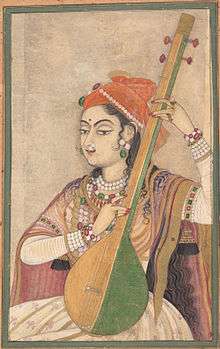Music of Bihar
Bihar is a state of India. The classical form of the Indian music is quite well known. Bihar has produced musicians like Bharat Ratna Ustad Bismillah Khan and dhrupad singers like the Malliks (Darbhanga Gharana) and the Mishras (Bettiah Gharana) along with poets like Bhikhari Thakur, the shakespeare of Bhojpuri and Vidyapati Thakur who contributed to Maithili Music. The classical music in Bihar is a form of the Hindustani classical music. This article deals with the folk culture of Bihar.
| Music of India | |
|---|---|
 A Lady Playing the Tanpura, c. 1735 (Rajasthan) | |
| Genres | |
| Traditional
Modern | |
| Media and performance | |
| Music awards | |
| Music festivals | |
| Music media | |
| Nationalistic and patriotic songs | |
| National anthem | Jana Gana Mana |
| Regional music | |
| |
The region's folk songs are associated with the various events in the life of an ordinary person. The historical ballads dealing with the heroic deeds of the freedom fighter Kunwar Singh have also been immortalized through folk songs in the plain tracts of Bihar. Religiosity is the pivot around which the music and amusements of the village folk of Bihar revolve. There are songs like sohar - performed during childbirth, sumangali - associated with wedding, ropnigeet - performed during the season of sowing paddy, katnigeet - performed during the paddy harvesting season.
The influence of Bihari music is seen in regions such as Mauritius, South Africa and the Caribbean, where many Bihari indentured labourers were taken during the nineteenth century as well as Pakistan and Bangladesh where many Bihari Muslims migrated to after the partition of India.
There is a great tradition of folk songs started by Bhikhari Thakur, an artist from the Bhojpur region. In the field Bhojpuri Music and Songs, there are notable works done by Mahendar Misir, Radhamohan Chaubey 'Anjan', Laxman Pathak Pradeep, and Sharda Sinha. Other wandering folk singers include the Kathaks, who travelled in groups and performed accompanied by dholak, sarangi, tamburu and majira. Other musician classes included Roshan Chouki, Bhajaniya, Kirtaniya, Pamaria and Bhakliya.
'Harkirtan' are famous religious folk songs. 'Astajam' are also famous religious folk songs in which 'Hare-Rama, Hare-Krishna' is sung regularly for twenty four hours at Hindu religious places.
In Bihar there is Caste Bhatt (Brahma Bhatt) whose tradition is singing and music. Although with the passage of time they have left there profession. Some small groups also sings Sohar songs at the birth time. Some transgender people (Kinners) also sing for livelihood money.
In village particularly some theatres are popular. 'Chand- Bijali' are very popular singer and dancer with their group from Village-Natwar of District-Sasaram. Her songs are very realistic although sometimes become little vulgar but liked by people.
An example of a very popular and unique folk dance is the Launda (Babua) Dance, in which male children dress themselves in female attire and dance in the female role. This is accompanied by folk song. This art is dying because artists do not get proper money and they do not get proper social respect. They never receive any awards.
There are many small groups who go to villages and sing folk songs and play Dholak, Harmonium etc. They are called by some 'STREET SINGERS'. They are the real Folk Singers today who are waiting for recognition, respect and money.
Small theatres are also important who give opportunities to small unrecognised artists. They are real entertainers, but sometimes they become vulgar.
'BABUA MANDALI' is working for development and restoration of the rich heritage of Folk Songs and Music of Bihar. Popular Male dancers are called 'Babua Dancer' not Launda Dancer. Female dancers are called 'Babuni Dancers' not Bar Dancers. 'Babua Mandali' have sung a popular 'CHAITA' song about the Great Tribal freedom fighter 'NILAMBAR-PITAMBER' of Latehar District of Jharkhand State which was earlier in Bihar State. Chero and Kharwar tribe of Palamu comissionory sing 'CHAITA' folk song in the month of chait.